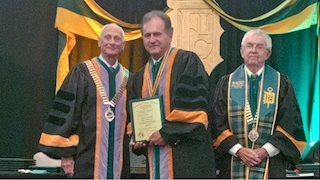First biomedical study of its kind at university
MORGANTOWN, W.Va. -- As more children than ever are being diagnosed with autism and a new generation of parents are raising their developing toddlers under a watchful eye, knowledge remains limited. A multidisciplinary team of researchers at West Virginia University hopes to gain some understanding about the mysterious autism spectrum by watching brains in action – and they want the public to get involved through the study’s crowdfunding page (http://wvuautismresearch.kintera.org), which includes a video explaining the project.
 The group is led by James W. Lewis, Ph.D., associate professor in the WVU School of Medicine Department of Neurobiology and Anatomy and the WVU Center for Neuroscience, and Paula Webster, a former autism therapist currently pursuing a doctorate in neuroscience at WVU. Through magnetic resonance imaging (MRI), Dr. Lewis and Webster will compare brain activity of individuals with autism, both children and adults, with the brain activity of individuals without autism. The study will be the first biomedical autism research undertaken at WVU.
The group is led by James W. Lewis, Ph.D., associate professor in the WVU School of Medicine Department of Neurobiology and Anatomy and the WVU Center for Neuroscience, and Paula Webster, a former autism therapist currently pursuing a doctorate in neuroscience at WVU. Through magnetic resonance imaging (MRI), Dr. Lewis and Webster will compare brain activity of individuals with autism, both children and adults, with the brain activity of individuals without autism. The study will be the first biomedical autism research undertaken at WVU.
“We’re interested in not just how individuals with autism hear and see things but also what brain pathways they are using,” Webster said. “We also want to take a look at how they are actually integrating that information to create a sense of their world around them.”
Webster compares the time frame in which someone with autism integrates information to watching a poorly dubbed movie.
“You can see lips moving, and you hear the sound,” she explained. “But they may not occur in the right time.”
The brain is organized to process specific types of sensory information and interactions between the senses (e.g. hearing and vision) in fairly well defined regions of the brain. Current thinking suggests that individuals with autism may have altered connections in the brain and may handle incoming information from the senses differently. Despite these differences, individuals with autism often demonstrate accuracy or reaction times that are better or as good as individuals without autism for some types of tasks. This suggests their brains have developed adaptive mechanisms, or ‘workarounds,’ to accomplish the same task.
“By imaging high-functioning autistic individuals while they perform an audiovisual integration task, we may be able to characterize some of these compensatory mechanisms,” Webster said. “Knowing how the brains of high-functioning autistic individuals work should be able to influence occupational therapy, applied behavior analysis, and physical therapy targeted toward development of skills via alterations in functional and structural connections in the brain.”
“Having a state-of-the-art center for brain imaging at WVU, this is an obvious project to pursue,” explained Dr. Lewis, who specializes in using imaging to examine brain function, including sensory processing, cognitive performance, and language. “In this era of needing more clinically related translatable research, this was a perfect project with Paula’s motivation, background, and drive for this project, as well as our neuroimaging capability at WVU.”
The study is a first for WVU in another respect. Lewis and Webster are the first at the WVU School of Medicine to attempt to fund a research study through online crowdsourcing, where private contributions are given directly from a large online community. Now an increasingly common practice at major research universities across the nation, reaching out to the public offers a novel way for citizens to directly impact research about which they feel passionate.
Webster hopes to raise at least $5,000 to cover the costs of imaging. One advantage of the project’s funding model offers is that donors can support specific scientific work in which they see value.
“This is a cutting-edge opportunity for WVU to add critical information to the body of knowledge of how people with autism experience the world,” Susannah Poe, Ed.D., autism project director at the WVU Center for Excellence in Disabilities, said. “This research can lead not only to better understanding for scholars but also to better treatments to help people with sensory challenges to manage daily life.”
As the study will compare brain scans of neurotypical individuals to those of participants on the autism spectrum, volunteers are needed. Those interested should contact Paula Webster at 304-293-8227.
To learn more about the WVU Center for Neuroscience, visit www.hsc.wvu.edu/wvucn.
For information about the WVU Center for Excellence in Disabilities, go to www.cedwvu.org.
Photo caption: Researcher Christopher Frum prepares a young research participant for MRI scanning. Brain activity images of children on the autism spectrum will be compared to age-matched, non-autistic peers.


